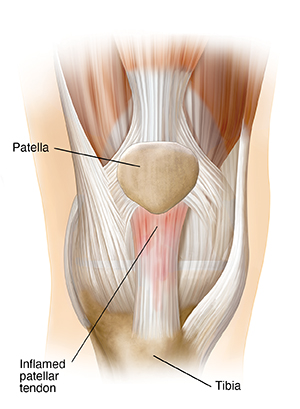When Your Child Has Jumper’s Knee
Your child has been diagnosed with a condition called jumper’s knee. Jumper’s knee is an irritation of the patellar tendon, which connects the kneecap (patella) to the shinbone (tibia). Your child will have some pain. But the pain should go away with correct care.

What causes jumper’s knee?
Jumper’s knee results from the knee being overworked. The condition often occurs while playing sports such as basketball and volleyball. Children who do track and field are also at risk. The constant jumping and landing motions of these activities put stress on the knees. The patellar tendon then becomes inflamed.
What are the signs and symptoms of jumper’s knee?
-
Pain at the bottom of the kneecap
-
Swelling around the bottom of the kneecap
-
Increased pain when the knee is flexed (bent)
-
Pain with activity
How is jumper’s knee diagnosed?
The healthcare provider will ask about your child’s health history and examine your child. During the exam, the provider checks your child’s knee for tenderness. Imaging tests, such as an X-ray, ultrasound, or magnetic resonance imaging (MRI), may also be done. Imaging tests show areas inside the body, such as the bones. They give the provider more information about your child’s injury.
How is jumper’s knee treated?
Your child’s healthcare provider will talk with you about the best treatment plan for your child. As instructed, your child should:
-
Rest from jumping or running until symptoms go away, often about 2 to 4 weeks.
-
If advised by your child's healthcare provider, ice the knee 3 to 4 times a day for 15 to 20 minutes at a time. Never put ice directly on your child's skin. Use an ice pack or bag of frozen peas—or something similar—wrapped in a thin towel.
-
Take anti-inflammatory medicine, such as ibuprofen, if directed by your child's healthcare provider.
-
Wear a patellar tendon strap (strap used to support the knee) during exercise, if instructed.
-
Do exercises at home as instructed by the healthcare provider. Your child may also be referred to a physical therapist (PT) for a supervised program of exercises. Your child’s PT or healthcare provider may also ask your child to do exercises at home.
Long-term concerns
With treatment, the injury should heal without any problems. After healing, any pain or restriction of the knee joint should go away. However, not resting correctly can result in a fracture and a longer period of being restricted from sports.
Online Medical Reviewer:
Raymond Turley Jr PA-C
Online Medical Reviewer:
Stacey Wojcik MBA BSN RN
Online Medical Reviewer:
Vinita Wadhawan Researcher
Date Last Reviewed:
12/1/2024
© 2000-2025 The StayWell Company, LLC. All rights reserved. This information is not intended as a substitute for professional medical care. Always follow your healthcare professional's instructions.